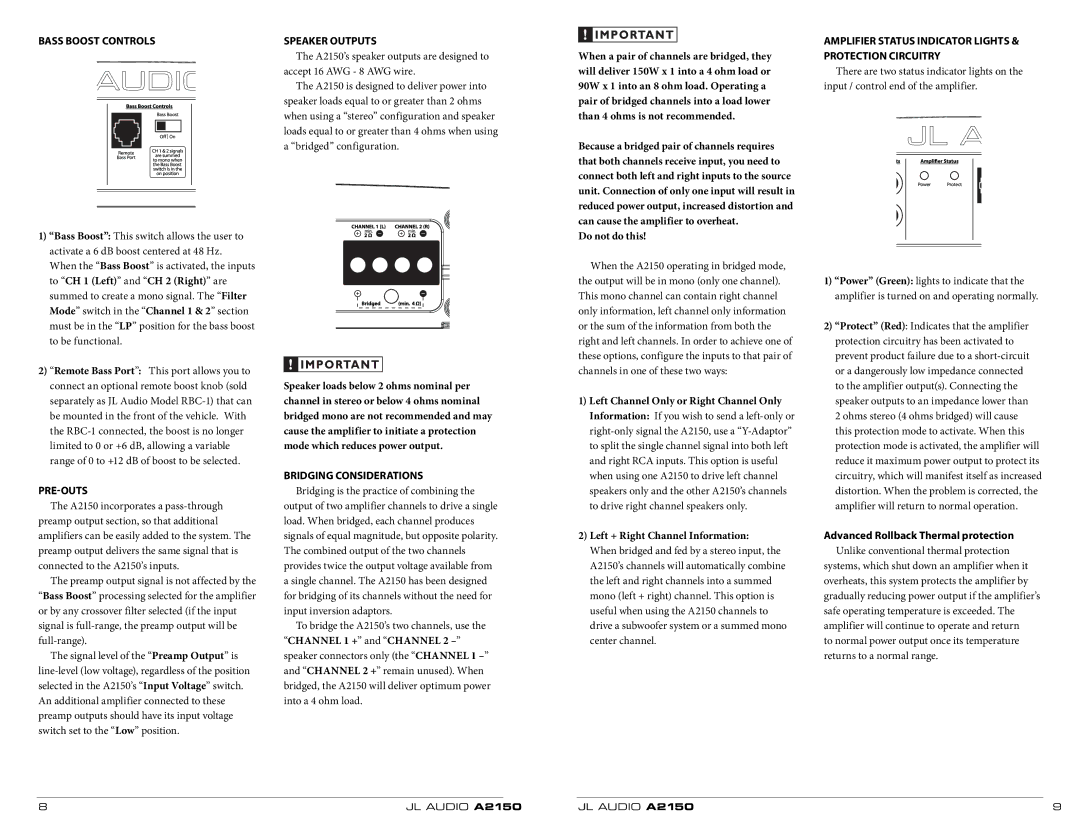
BASS BOOST CONTROLS
1)“Bass Boost”: This switch allows the user to activate a 6 dB boost centered at 48 Hz.
When the “Bass Boost” is activated, the inputs to “CH 1 (Left)” and “CH 2 (Right)” are summed to create a mono signal. The “Filter Mode” switch in the “Channel 1 & 2” section must be in the “LP” position for the bass boost to be functional.
2)“Remote Bass Port”: This port allows you to connect an optional remote boost knob (sold separately as JL Audio Model
PRE-OUTS
The A2150 incorporates a
The preamp output signal is not affected by the “Bass Boost” processing selected for the amplifier or by any crossover filter selected (if the input signal is
The signal level of the “Preamp Output” is
SPEAKER OUTPUTS
The A2150’s speaker outputs are designed to accept 16 AWG - 8 AWG wire.
The A2150 is designed to deliver power into speaker loads equal to or greater than 2 ohms when using a “stereo” configuration and speaker loads equal to or greater than 4 ohms when using a “bridged” configuration.
Speaker loads below 2 ohms nominal per channel in stereo or below 4 ohms nominal bridged mono are not recommended and may cause the amplifier to initiate a protection mode which reduces power output.
BRIDGING CONSIDERATIONS
Bridging is the practice of combining the output of two amplifier channels to drive a single load. When bridged, each channel produces signals of equal magnitude, but opposite polarity. The combined output of the two channels provides twice the output voltage available from a single channel. The A2150 has been designed for bridging of its channels without the need for input inversion adaptors.
To bridge the A2150’s two channels, use the “CHANNEL 1 +” and “CHANNEL 2
When a pair of channels are bridged, they will deliver 150W x 1 into a 4 ohm load or 90W x 1 into an 8 ohm load. Operating a pair of bridged channels into a load lower than 4 ohms is not recommended.
Because a bridged pair of channels requires that both channels receive input, you need to connect both left and right inputs to the source unit. Connection of only one input will result in reduced power output, increased distortion and can cause the amplifier to overheat.
Do not do this!
When the A2150 operating in bridged mode, the output will be in mono (only one channel). This mono channel can contain right channel only information, left channel only information or the sum of the information from both the right and left channels. In order to achieve one of these options, configure the inputs to that pair of channels in one of these two ways:
1)Left Channel Only or Right Channel Only Information: If you wish to send a
2)Left + Right Channel Information: When bridged and fed by a stereo input, the A2150’s channels will automatically combine the left and right channels into a summed mono (left + right) channel. This option is useful when using the A2150 channels to drive a subwoofer system or a summed mono center channel.
AMPLIFIER STATUS INDICATOR LIGHTS & PROTECTION CIRCUITRY
There are two status indicator lights on the input / control end of the amplifier.
1)“Power” (Green): lights to indicate that the amplifier is turned on and operating normally.
2)“Protect” (Red): Indicates that the amplifier protection circuitry has been activated to prevent product failure due to a
Advanced Rollback Thermal protection
Unlike conventional thermal protection systems, which shut down an amplifier when it overheats, this system protects the amplifier by gradually reducing power output if the amplifier’s safe operating temperature is exceeded. The amplifier will continue to operate and return
to normal power output once its temperature returns to a normal range.
8 | JL AUDIO A2150 | JL AUDIO A2150 | 9 |
